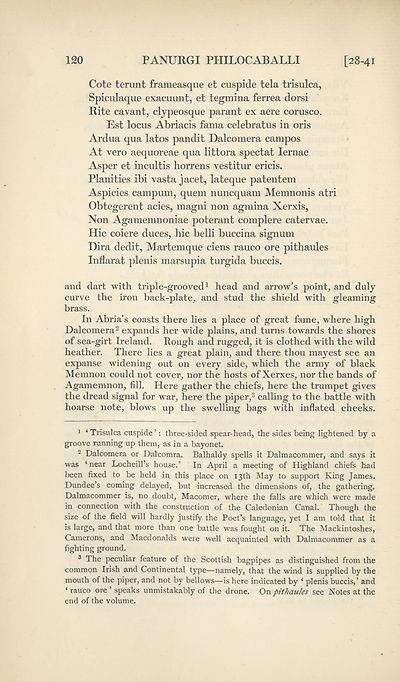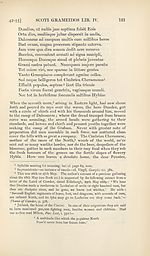Series 1 > Grameid: an heroic poem descriptive of the campaign of Viscount Dundee in 1689, and other pieces
(191) Page 120
Download files
Complete book:
Individual page:
Thumbnail gallery: Grid view | List view

120
PANURGI PHILOCABALLI
[28-41
Cote terunt frameasque et cuspide tela trisulca,
Spiculaque exacuunt, et tegmina ferrea dorsi
Rite cavant, clypeosque parant ex acre corusco.
Est locus Abriacis fama celebratus in oris
Ardua qua latos pandit Dalcomera campos
At vero aequoreae qua littora spectat lernae
Asper et incultis horrens vestitur ericis.
Planities ibi vasta jacet, lateque patentem
Aspicies campum, quem nuncquam Memnonis atri
Obtegerent acies, naagni non agmina Xerxis,
Non Agamemnoniae poterant complere catervae.
Hie coiere duces, hie belli buccina signum
Dira dedit, Martemque ciens rauco ore pithaules
Inflarat plenis xnarsupia turgida buccis.
and dart with triple-grooved1 head and arrow’s point, and duly
curve the iron back-plate, and stud the shield with gleaming
brass.
In Abria’s coasts there lies a place of great fame, where high
Dalcomera2 expands her wide plains, and turns towards the shores
of sea-girt Ireland. Rough and rugged, it is clothed with the wild
heather. There lies a great plain, and there thou mayest see an
expanse widening out on every side, which the army of black
Memnon could not cover, nor the hosts of Xerxes, nor the bands of
Agamemnon, fill. Here gather the chiefs, here the trumpet gives
the dread signal for war, here the piper,3 calling to the battle with
hoarse note, blows up the swelling bags with inflated cheeks.
] ‘Trisulca cuspide’: three-sided spear-head, the sides being lightened by a
groove running up them, as in a bayonet.
2 Dalcomera or Dalcomra. Balhaldy spells it Dalmacommer, and says it
was ‘near Locheill’s house.’ In April a meeting of Highland chiefs had
been fixed to be held in this place on 13th May to support King James.
Dundee’s coming delayed, but increased the dimensions of, the gathering.
Dalmacommer is, no doubt, Macomer, where the falls are which were made
in connection with the construction of the Caledonian Canal. Though the
size of the field will hardly justify the Poet’s language, yet I am told that it
is large, and that more than one battle was fought on it. The Mackintoshes,
Camerons, and Macdonalds were well acquainted with Dalmacommer as a
fighting ground.
3 The peculiar feature of the Scottish bagpipes as distinguished from the
common Irish and Continental type—namely, that the wind is supplied by the
mouth of the piper, and not by bellows—is here indicated by ‘ plenis buccis,’ and
‘ rauco ore ’ speaks unmistakably of the drone. On pithaules see Notes at the
end of the volume.
PANURGI PHILOCABALLI
[28-41
Cote terunt frameasque et cuspide tela trisulca,
Spiculaque exacuunt, et tegmina ferrea dorsi
Rite cavant, clypeosque parant ex acre corusco.
Est locus Abriacis fama celebratus in oris
Ardua qua latos pandit Dalcomera campos
At vero aequoreae qua littora spectat lernae
Asper et incultis horrens vestitur ericis.
Planities ibi vasta jacet, lateque patentem
Aspicies campum, quem nuncquam Memnonis atri
Obtegerent acies, naagni non agmina Xerxis,
Non Agamemnoniae poterant complere catervae.
Hie coiere duces, hie belli buccina signum
Dira dedit, Martemque ciens rauco ore pithaules
Inflarat plenis xnarsupia turgida buccis.
and dart with triple-grooved1 head and arrow’s point, and duly
curve the iron back-plate, and stud the shield with gleaming
brass.
In Abria’s coasts there lies a place of great fame, where high
Dalcomera2 expands her wide plains, and turns towards the shores
of sea-girt Ireland. Rough and rugged, it is clothed with the wild
heather. There lies a great plain, and there thou mayest see an
expanse widening out on every side, which the army of black
Memnon could not cover, nor the hosts of Xerxes, nor the bands of
Agamemnon, fill. Here gather the chiefs, here the trumpet gives
the dread signal for war, here the piper,3 calling to the battle with
hoarse note, blows up the swelling bags with inflated cheeks.
] ‘Trisulca cuspide’: three-sided spear-head, the sides being lightened by a
groove running up them, as in a bayonet.
2 Dalcomera or Dalcomra. Balhaldy spells it Dalmacommer, and says it
was ‘near Locheill’s house.’ In April a meeting of Highland chiefs had
been fixed to be held in this place on 13th May to support King James.
Dundee’s coming delayed, but increased the dimensions of, the gathering.
Dalmacommer is, no doubt, Macomer, where the falls are which were made
in connection with the construction of the Caledonian Canal. Though the
size of the field will hardly justify the Poet’s language, yet I am told that it
is large, and that more than one battle was fought on it. The Mackintoshes,
Camerons, and Macdonalds were well acquainted with Dalmacommer as a
fighting ground.
3 The peculiar feature of the Scottish bagpipes as distinguished from the
common Irish and Continental type—namely, that the wind is supplied by the
mouth of the piper, and not by bellows—is here indicated by ‘ plenis buccis,’ and
‘ rauco ore ’ speaks unmistakably of the drone. On pithaules see Notes at the
end of the volume.
Set display mode to:
![]() Universal Viewer |
Universal Viewer | ![]() Mirador |
Large image | Transcription
Mirador |
Large image | Transcription
Images and transcriptions on this page, including medium image downloads, may be used under the Creative Commons Attribution 4.0 International Licence unless otherwise stated. ![]()
| Scottish History Society volumes > Series 1 > Grameid: an heroic poem descriptive of the campaign of Viscount Dundee in 1689, and other pieces > (191) Page 120 |
|---|
| Permanent URL | https://digital.nls.uk/126597849 |
|---|
| Attribution and copyright: |
|
|---|
| Description | Over 180 volumes, published by the Scottish History Society, containing original sources on Scotland's history and people. With a wide range of subjects, the books collectively cover all periods from the 12th to 20th centuries, and reflect changing trends in Scottish history. Sources are accompanied by scholarly interpretation, references and bibliographies. Volumes are usually published annually, and more digitised volumes will be added as they become available. |
|---|


